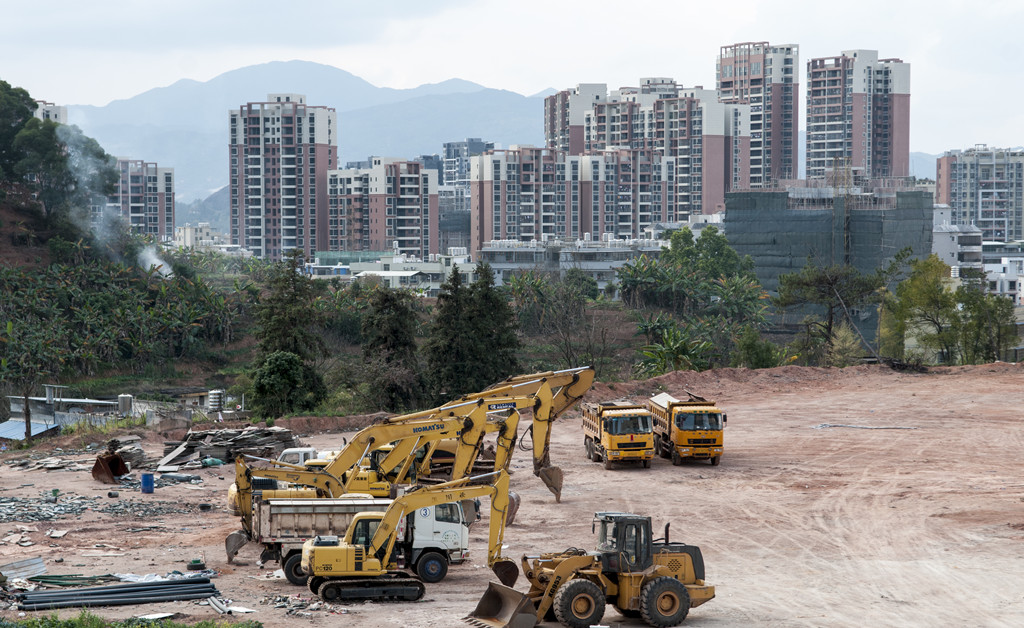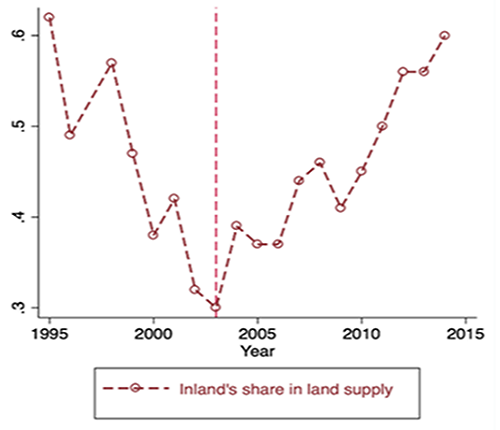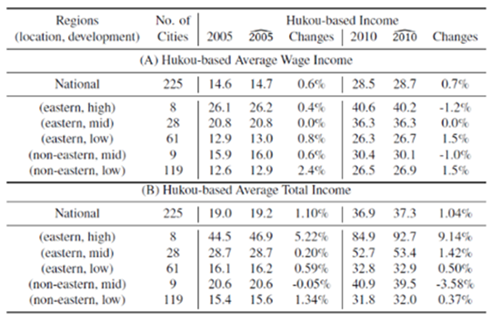Does China’s Place-Based Land Policy Lead to Spatial Misallocation?
After 2003, the Chinese central government implemented an inland-favoring land supply policy that distributed more construction land quotas to underdeveloped non-eastern regions. We investigate the effect of the policy and find that it drastically increased land and housing prices in more-developed eastern regions, which consequently created substantial spatial misallocation of land and labor. The policy seems to reduce regional output gaps; however, it hurt workers from underdeveloped regions by hindering their migration to developed regions and caused national TFP and output losses.

Policy Background
In 2003, the Chinese central government started to implement an inland-favoring land supply policy, which allocated more land quotas to inland regions rather than eastern regions. Thus, the new land supply was reduced in the eastern region and the region has not been able to catch up with the high demand created by fast economy growth. Even though there is still undeveloped land around developed cities (Yu, 2019), developed cities are forbidden from increasing the land supply more than their quotas. The policy aimed to mitigate the unbalanced development across regions due to the rapid economic growth in the east near the coastline. As shown in Figure 1, the inland share of land supply has a clear turning point in 2003 and kept increasing after that. The effect of this policy has been controversial, and many economists argue that it may have led to spatial resource misallocation during the last two decades. (Liang et al., 2011; Lu and Xiang, 2016; Han and Lu, 2017)
Figure 1 Inland Share of Land Supply

General Findings
In our recent working paper (Fang et al., 2021), we find that after the implementation of the inland-favoring policy, land and land price increases become more constrained in the eastern regions, which leads to increases in floor space costs. It then deters the migration of workers from the inland regions to the eastern regions, which have higher productivity. The misallocation of land and labor leads to reductions in national output and productivity. The income of workers from underdeveloped regions is also reduced since many migrants are locked into their hometowns and lose their chance to migrate to more productive eastern cities with higher wages. Thus, this policy hurt the people it intended to help.
We analyze the consequences of this policy change in two steps. First, we employ a method combining border regression discontinuity (Black, 1999) and difference-in-differences approaches (RD-DID) to empirically investigate the effect of the inland-favoring land policy on land prices and firm-level TFP in different regions. The identification strategy relies on the comparisons of land prices/firm-level TFP before and after the policy year (2003) for land/firms just around the eastern and non-eastern border. Land price data are collected from the China Land Market Website at the land parcel level. Firm-level TFP is calculated using data from the National Industrial Enterprise Database. We find that the 2003 inland-favoring policy led to a 3.3–9.4% increase in land prices in the developed eastern region compared with the inland region. Furthermore, this policy also reduced firm-level TFP in the eastern region by 0.24–0.49% compared with the inland region.
Second, we construct a spatial equilibrium model (Ahlfeldt et al., 2015) to quantify the aggregate effects of China's land supply scheme. In the model, each worker is endowed with a home location and a skill level. Each worker decides his or her working location based on wages, housing costs, migration costs, and random amenity shocks. The floor space market is separated into a residential housing market and a production floor space market. The floor space prices are determined by land supply, and floor space is determined from demand from residents and firms. We calibrate and quantify the model using data from the Population Census, the City Statistic Yearbooks, and the Urban Statistic Yearbook in 2005 and 2010. In the counterfactual analysis, we examine what would happen if the central government had not implemented the inland-favoring policy. We find that this would increase land supply in eastern cities with higher productivity and would decrease their floor space prices. It would attract more migrants to these cities and would result in a 2.2% (2.4%) increase in total national output in 2005 (2010). We also find that the productivity loss due to the inland-favoring policy is enormous. If we remove the policy, national TFP would increase by 6.2% in 2005 and by 7.3% in 2010.
The recission of the policy would also reduce output and productivity in underdeveloped cities and cause a larger regional output gap, which suggests that the inland-favoring policy achieves regional convergence by balancing regional development. But the regional convergence is just an illusion. Table 1 shows the changes in incomes of workers from different hometowns. We find that removing the inland-favoring policy would lead to increases in wages and total income for workers from almost all places. Specifically, there is a 1–2% increase in the average wage and total income of workers from underdeveloped areas.Table 1 Removing the Inland-favoring Policy: Worker Incomes

Conclusion
The inland-favoring land supply policy resulted in severe land and labor misallocation. It not only caused overall output and TFP losses, but also hurt workers from underdeveloped regions by hindering their migration. The convergence between regions is just an illusion since almost all workers across China were hurt, including those from poor areas.
(Min Fang, University of Lausanne and University of Geneva; Libin Han, Dongbei University of Finance and Economics; Zibin Huang, Shanghai University of Finance and Economics; Ming Lu, Shanghai Jiaotong University; Li Zhang, Sun Yat-Sen University.)
References
Ahlfeldt, Gabriel M, Stephen J Redding, Daniel M Sturm, and Nikolaus Wolf. 2015. “The Economics of Density: Evidence from the Berlin Wall.” Econometrica 83 (6):2127–2189.
Black, Sandra E. 1999. “Do Better Schools Matter? Parental Valuation of Elementary Education.” The Quarterly Journal of Economics 114 (2):577–599.
Fang, Min, Libin Han, Zibin Huang, Ming Lu, and Li Zhang. 2021. “Regional Convergence or Just an Illusion? Place-Based Land Policy and Spatial Misallocation in China” Working Paper, Available at SSRN (https://papers.ssrn.com/sol3/papers.cfm?abstract_id=3846313).
Han, Libin and Ming Lu. 2017. “Housing Prices and Investment: An Assessment of China’s Inland-Favoring Land Supply Policies.” Journal of the Asia Pacific Economy 22 (1):106–121.
Liang, Wenquan, Ming Lu, and Hang Zhang. 2016. “Housing Prices Raise Wages: Estimating the Unexpected Effects of Land Supply Regulation in China.” Journal of Housing Economics 33:70–81.
Lu, Ming and Kuanhu Xiang. 2016. “Great Turning: How Has the Chinese Economy Been Trapped in an Efficiency-and-Balance Tradeoff?” Asian Economic Papers 15 (1):25–50.
Neumark, David and Helen Simpson. 2015. “Place-Based Policies.” In Handbook of Regional and Urban Economics, vol. 5. Elsevier, 1197–1287.
Yu, Yue. 2019. “Land-Use Regulation and Economic Development: Evidence from the Farmland Red Line Policy in China.” Working Paper.

Latest
Most Popular
- VoxChina Covid-19 Forum (Second Edition): China’s Post-Lockdown Economic Recovery VoxChina, Apr 18, 2020
- China’s Great Housing Boom Kaiji Chen, Yi Wen, Oct 11, 2017
- China’s Joint Venture Policy and the International Transfer of Technology Kun Jiang, Wolfgang Keller, Larry D. Qiu, William Ridley, Feb 06, 2019
- The Dark Side of the Chinese Fiscal Stimulus: Evidence from Local Government Debt Yi Huang, Marco Pagano, Ugo Panizza, Jun 28, 2017
- Wealth Redistribution in the Chinese Stock Market: the Role of Bubbles and Crashes Li An, Jiangze Bian, Dong Lou, Donghui Shi, Jul 01, 2020
- What Is Special about China’s Housing Boom? Edward L. Glaeser, Wei Huang, Yueran Ma, Andrei Shleifer, Jun 20, 2017
- Evaluating Risk across Chinese Housing Markets Yongheng Deng, Joseph Gyourko, Jing Wu, Aug 02, 2017
- Privatization and Productivity in China Yuyu Chen, Mitsuru Igami, Masayuki Sawada, Mo Xiao, Jan 31, 2018
- How did China Move Up the Global Value Chains? Hiau Looi Kee, Heiwai Tang, Aug 30, 2017
- China’s Shadow Banking Sector: Wealth Management Products and Issuing Banks Viral V. Acharya, Jun Qian, Zhishu Yang, Aug 09, 2017




 Facebook
Facebook  Twitter
Twitter  Instagram
Instagram WeChat
WeChat  Email
Email 



